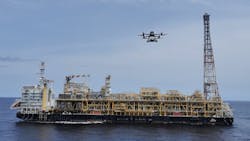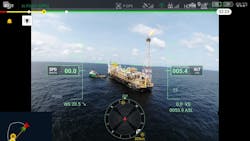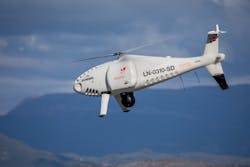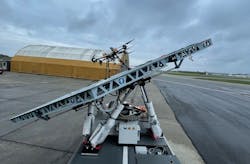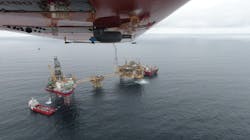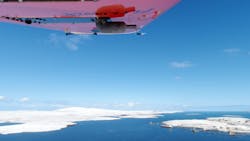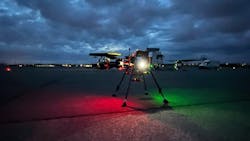Offshore drone use faces challenges but offers more solutions
Editor's note: This story first appeared in the July-August 2022 issue of Offshore magazine. Click here to view the full issue.
By Ariana Hurtado, Editor and Director of Special Reports
Drones have proven to be an asset for offshore operators, as they provide a faster, safer and more cost-efficient solution for the inspection and maintenance of offshore oil and gas facilities.
"In offshore oil and gas facilities inspection, the use of drones allows teams to go in confined spaces without exposing persons," a TotalEnergies spokesperson told Offshore magazine. "It is also a way to survey high points without scaffolding. Thickness sensors can be loaded in drones and allow survey teams to monitor and remotely prepare maintenance operations with the same accuracy."
Main use cases for unmanned aerial vehicles (UAVs), or drones, as explained by TotalEnergies, include:
- Pipeline right of way surveys (e.g., GIS updates);
- XYZ topographic surveys (e.g., production of 3D point clouds, digital surface models and digital elevation models);
- Visual and/or thermography inspections (confined spaces or height inspection);
- Detection, location and description of anomalies on the equipment;
- Outcrop modeling surveys (e.g., hyperspectral imagery/3D point clouds); and
- Gas leak detection and emissions monitoring.
UAV efficiency
“The use of UAV has increased over the past couple years to increase the efficiency and the security of our operations,” the TotalEnergies spokesperson said.
A routine maintenance inspection of one or more offshore installations can be done faster and safer using a drone, added Pål Kristensen, vice president of logistics with Nordic Unmanned, a provider of drone systems and services.
“A drone can get to difficult locations, in a safe manner, without the use of wires, cranes and people,” he told Offshore magazine. “Without these added elements, the inspection can be done faster and thus more cost-efficient.”
With personnel safety a top priority at companies, drones also provide a better option for transporting products, performing inspections and/or maintenance.
“A drone is safer, as it can access areas where gas is likely to be present,” Kristensen said. “It can also be a resource if there are any accidents that need to be inspected from a safe distance. In addition, by using automation, you remove the risk of human error and therefore provide a more reliable service.”
Challenges
Drones face several challenges offshore that can include simultaneous operations, maximum altitude, not being ATEX-rated, battery logistics, registration, pilot trainings, and take-off and landing positions can be different depending on metocean conditions, the TotalEnergies representative said.
There are also other hurdles being faced by Nordic and other drone service providers, as Kristensen explained that UAVs are designed to perform in various conditions but operating offshore has its own set of challenges.
“Harsh weather conditions are often found offshore, especially high and gusty wind and humidity,” he said. “In addition to environmental conditions, we operate in locations that may have limited communication possibilities and where other aircraft, like helicopters, regularly use the same airspace and helidecks. We also need to properly plan deployments to ensure the high availability of the service, meaning that operations and maintenance plans have to be adapted to the offshore industry’s needs and schedules.”
Solutions
The industry has never shied away from a technological challenge, and UAVs will continue to be tweaked over time to become even more efficient.
“Higher capabilities of UAVs to safely operate in demanding environments and advanced communications and detect-and-avoid functions will contribute to improving the possibilities to deploy this technology in more areas,” Nordic’s Kristensen said. “Sensors and logistics integration, like the possibility to drop or pick up loads from the ocean, will continue to evolve, and we will see greater integration with the underwater world as well.”
He also emphasized the need to deploy remotely piloted aircrafts systems that require as few remote crew personnel as possible offshore to take into consideration the limitations of available space for offshore staff.
Additionally, the TotalEnergies representative suggested a number of potential improvements to drones, such as incorporating autonomous modes, increasing flight duration capabilities, increasing accuracy positioning of drones and allowing them to land in autonomous flight mode on mobile ships, adding telecom capabilities to communicate directly to shore, and including a wind sensor on board.
According to Chris Adams, business development director with drones service provider Flylogix, there is not a one-size-fits-all approach to addressing drone challenges offshore. He added that continued support of regulators, air traffic services, the wider aviation community, search and rescue, and the military are all vital to the long-term and sustainable integration of unmanned systems into the wider aviation ecosystem.
“It has become clear that there is not a one-size-fits-all approach, but by solving the problem piece by piece, the whole sector is making steady progress forward,” Adams told Offshore magazine. “Underpinning this change is the offshore industry, which has set out a clear commercial requirement for these services and as such acting as a key driving force for innovation and change.”
Drone offshore logistics
UAVs and drones are taking on a larger role in offshore energy operations, according to Nordic’s Kristensen.
“UAV capabilities are evolving beyond the initial years of experimental demonstration flights and are now being considered as part of business operations in many areas,” he said. “They can accomplish tasks in complement to other existing means, helicopters, airplanes, vessels or human manual interventions. UAVs are now integrated into offshore energy operations, with Equinor taking the lead as the first operator to start offshore logistics using drones. The offshore logistics service is just one of many possibilities for UAVs in offshore operations.”
The companies first concluded a three-week onshore test phase, where the Nordic team successfully verified the readiness for offshore logistics services. The companies conducted several trials and demonstrations of drone logistics services.
The offshore work scope will include multiple daily cargo flights between the installations at the Gullfaks Field as well as between offshore installations and vessels in the Tampen area.
These drone offshore logistics operations will “significantly improve the efficiency of offshore logistics and will reduce emissions, leading the industry toward a more sustainable future,” according to a recent Nordic press release.
As UAV technology and techniques evolve, offshore inspection, data gathering and logistics are becoming more efficient.
“Through a step-by-step approach, where risk, maturity and complexity are mapped, we have gradually advanced our operations’ complexity,” Kristensen said. “Together with Equinor, we are pushing the boundaries of what drones can do offshore, providing solutions that are more sustainable, scalable and cost-efficient. To do so, one needs to understand the offshore business as well as the aviation business and implement safe processes at pace.”
Measuring methane emissions
Flylogix deploys its drones, combined with artificial intelligence, satellite communications and methane sensor technology supplied by SeekOps, to monitor and measure methane emissions.
Flylogix has worked with six major energy companies to measure methane emissions in the North Sea. The company began working with bp a few years ago in an ongoing effort to create a measurement blueprint that can be utilized for other sites by 2023, reduce operational human risk to acquire measurement readings as well as quickly and accurately supply data.
Flylogix is working with bp to monitor its North Sea facilities. The UAVs take measurements with a focus on achieving consistent and reliable emissions reporting. bp’s goal is to install methane measurement on all its main oil and gas processing sites by 2023 and achieve a 50% reduction in methane intensity across its operations.
“Measuring methane emissions from offshore assets has, until now, been difficult, expensive, unreliable and—in itself—a source of high carbon emissions, depending as it often does on manned vehicle flights,” according to a recent Flylogix press release.
According to Adams, when compared to manned aviation, UAVs are up to one-fifth the cost, offer as much as 98% lower emissions and entirely remove the risk of additional people flying offshore to work in these challenging remote environments.
Drones can provide better options for accessing remote areas, difficult-to-reach offshore structures or potentially dangerous zones. Adams said one of the most significant offerings Flylogix has developed, in partnership with SeekOps, is its service to accurately measure methane emissions.
“In the wake of COP26, the global methane pledge and the ambitious operator-led targets for achieving net zero, understanding methane intensity is vital for the energy sector,” he said. “Our service enables operators to quantify total asset emissions without disrupting production, taking up bed-space offshore or incurring disproportionate costs.”
To assist in the inspection and maintenance of offshore oil and gas facilities, Flylogix has permanent hubs set up in Shetland, Aberdeen and Norfolk enabling it to serve all areas of the North Sea without the need to transport equipment around. The company also recently opened an office in Norway and has a campaign in Trinidad and Tobago scheduled for later this year.
“Long-range unmanned systems remove the need to transport people offshore to conduct services such as emissions monitoring or visual inspection,” Adams added. “This doesn't just reduce the risk to people but also speeds up the flow of data back to where it matters most.”
Timing is critical for any service provider but so is ensuring its technology can withstand the challenging offshore environment.
“The offshore environment is dynamic, busy and harsh,” Adams said. “That is why we are so relentless in ensuring our technology is robust, proven and dependable. You are entering a complex operating environment, and there is always a busy schedule of work that you need to fit into. Success comes from ensuring everything is ready so that when you get your slot, you are able to go and get the job done.”
Drones are “maturing into a real service,” he said, as offshore teams are now calling on drone providers the same way they would for routine helicopter flights.
“The biggest evolution is seeing these services transition into routine operations within the offshore ecosystem,” Adams said.
Tech advancements
TotalEnergies launched a drone-based emissions detection and quantification campaign in May across all its upstream oil and gas operated sites. The campaign uses AUSEA (Airborne Ultralight Spectrometer for Environmental Applications) technology, which is a greenhouse-gas quantification technology that comprises a miniature dual sensor mounted on a drone that detects methane and CO2 emissions and identifies the source.
The technology has been successfully tested at sites in Nigeria, Italy, the Republic of the Congo and the Netherlands. The campaign began in early March for African offshore sites, has been launched in South America and was scheduled to begin in Europe this summer.
In addition, Nordic recently acquired DroneMatrix, a Belgian provider of automated drones, in May. Kristensen said this acquisition, which included DroneMatrix’s mature drone-in-a-box technology, “will contribute to enhancing our inspection and cargo capabilities using remotely controlled assets.”
At Flylogix, Adams said unmanned aerial systems are available and streaming data, and the company intends to “keep building on that value.” He also said Flylogix is constantly aiming to increase the level of automation, drive down costs and improve safety for offshore drone use.
“We are focused on ensuring our R&D energy is aligned to services that the industry needs—that's the sweet spot,” Adams concluded. “The demand to expand into new territories is really accelerating so we are making sure we can support that. Now we are routinely in the field, [and] we are working with operators on what other datasets they want.”
About the Author
Ariana Hurtado
Editor-in-Chief
With more than a decade of copy editing, project management and journalism experience, Ariana Hurtado is a seasoned managing editor born and raised in the energy capital of the world—Houston, Texas. She currently serves as editor-in-chief of Offshore, overseeing the editorial team, its content and the brand's growth from a digital perspective.
Utilizing her editorial expertise, she manages digital media for the Offshore team. She also helps create and oversee new special industry reports and revolutionizes existing supplements, while also contributing content to Offshore's magazine, newsletters and website as a copy editor and writer.
Prior to her current role, she served as Offshore's editor and director of special reports from April 2022 to December 2024. Before joining Offshore, she served as senior managing editor of publications with Hart Energy. Prior to her nearly nine years with Hart, she worked on the copy desk as a news editor at the Houston Chronicle.
She graduated magna cum laude with a bachelor's degree in journalism from the University of Houston.
